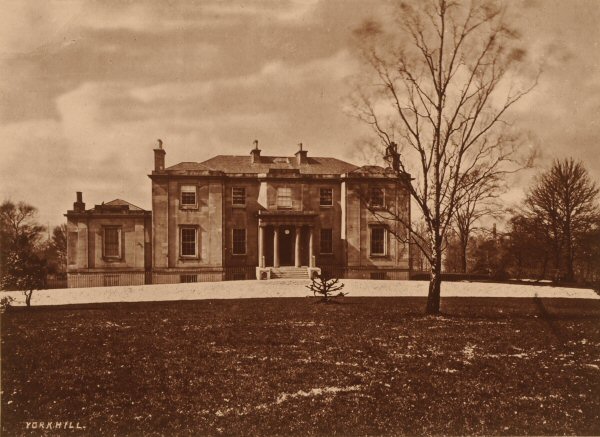

THIS fine edifice and its beautiful grounds are situated on the south side of the old road leading to Partick, a short distance beyond the point where it diverges from the new one. The house stands on an eminence, overlooking an extensive and picturesque landscape.
The ancient name of the lands was "Over Newton." They embraced about sixty acres, including two portions of Kelvinhaugh, and stretched southwards to the Clyde. They marched on the east with the lands of Stobcross. One of the parks or fields of Over Newton was known as "The Yorkhill Park," and consisted of twenty-two acres. In modern times this more euphonious appellation was given to that portion of Over Newton on which Yorkhill House stands, as well as to the grounds now forming the Yorkhill Estate. But the old name still rests on a minor section of the original Over Newton, immediately to the east.
There are reasons for supposing that a small old Roman station existed on Yorkhill. In the spring of 1868, while workmen were trenching ground on the summit of the eminence, at a place where faint indications of what seemed to have been earthworks had long been observed, they turned up Roman remains. These consisted of several Roman coins in large brass, one of which, in tolerable preservation, was of Trajan, the others, though much defaced, had the unmistakable Roman character, bronze finger-rings, wheat for making the soldiers' bread, which must have been imported as it was not indigenous to Britain, Roman pottery of the well known Samian manufacture, in fragments of amphorae, jars, bowls, and other fictile vessels; also, pieces of what had been a very delicately formed and ornamental small glass vase, indicating the presence of luxury.
This discovery is the more interesting, because previously almost no traces of Roman footsteps had been revealed in the district of what is now Glasgow.
The eminence of Yorkhill was a prominent object, and likely to have arrested the attention of the Roman officers in their early exploration of this then wild and unknown country, when seizing every point of advantage. This rising ground is isolated; it is near the embouchure of the Kelvin, and overlooked the old ford in the Clyde where the two streams meet, thus forming a good and almost necessary point for military surveillance.
Nothing, therefore, is more likely than that a small fort was placed on the summit of the eminence where the remains were found. It may have been held perhaps by a centurion's guard, drafted from the garrison in the large camps which existed at what is now Paisley, only a few miles distant, and marked as "Vanduara" on Ptolemy's map in the middle of the second century. The communication for receiving supplies and reinforcements in case of need at this small outlying fort would be easy by means of the Roman via and the ford in the river. If a surmise may be hazarded as to the probable era of this occupation of Yorkhill, the coin of Trajan would seem to point either to his reign or that of Hadrian, his successor, the latter of whom ascended the throne A.D. 117, and indeed may have visited the spot in the course of the careful survey which that warlike emperor made of the whole of his dominions and fortifications, consuming in the Herculean task more than eighteen years. By the time of Antoninus Pius there would probably have been less occasion for this minor station, as the barrier across the country which bore his name, and was constructed about the year 140, would afford full protection to the Roman province within its pale, and therefore Yorkhill fort may have fallen into disuse even before the legions withdrew from Caledonia.
But leaving these remote times and approaching our own, the general property of Over Newton belonged, in the early part of last century, to Crawford of Milton, and subsequently to George Bogle and Robert Barclay, two well known old citizens. They sold Over Newton to different persons. An advertisement by them, offering the property for sale publicly, appeared in the Glasgow journal of 26th June 1777, wherein the Yorkhill Park is particularly mentioned as part of the lands. The notice is otherwise curious.
In the beginning of the present century the westmost section of Over Newton, including the park of Yorkhill, became the property of Robert Fulton Alexander, merchant in Glasgow, who, about 1805, erected the mansion on the eminence, now photographed, and gave the general name of "Yorkhill" to it and to the lands he had acquired.
In 1813 Yorkhill House and grounds were sold to Mr. Andrew Gilbert, merchant in Glasgow. This well known gentleman purchased other lands adjoining, and included these under the general title of Yorkhill estate. The whole property was subsequently entailed by him in favour of the daughter of his deceased brother, and a certain order of heirs. This lady became the wife of the lamented Mr. John Graham, the eminent artist, son of a West India merchant, and on her succession to Yorkhill he took the additional surname of Gilbert, in terms of the entail, thus latterly being more generally known and remembered as Mr. Graham Gilbert. The right hand wing was added by him.
Back to Contents